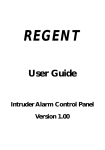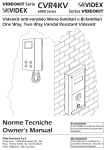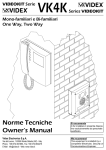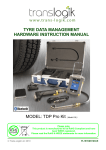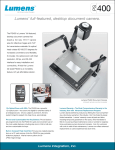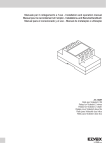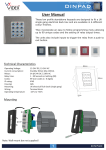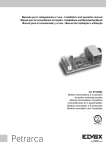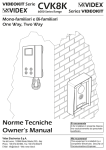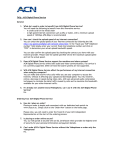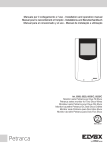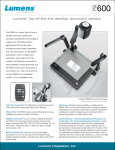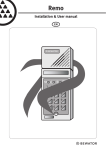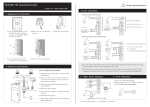Download Norme Tecniche Owner`s Manual
Transcript
VIDEOKIT Serie CVK4K 6000 Series Series VIDEOKIT Mono-familiari e Bi-familiari One Way, Two Way Norme Tecniche Owner’s Manual Videx Electronics S.p.A. Via del Lavoro, 1 63846 Monte Giberto (FM) - Italy Phone +39 0734 631669 - Fax +39 0734 632475 E-Mail [email protected] - Web: www.videx.it Si raccomanda di far installare il presente dispositivo esclusivamente da personale qualificato. We recommend This equipment is installed by a Competent Electrician, Security or Communications Engineer. CVK4K/6000, CVK4K-S/6000 CVK4K/6000, CVK4K-S/6000 Videokit Monofamiliare con videocitofono e telecamera a colori One way videoki with Colour videophone and camera I videokit della serie CVK4K fanno parte di una nuova linea che utilizza il posto esterno con design Serie 4000. Il videocitofono fornito a corredo è Serie 6000 in una versione espressamente progettata per questa linea di videokit. L’unità di ripresa ha le dimensioni di un modulo della Serie 4000 ed è corredato dal relativo supporto da incasso (CVK4K) o superficie (CVK4K-S) in base alla versione del kit. Grazie all’impiego della tecnologia a microprocessore sia nel modulo portiere elettrico - unità di ripresa che nel videocitofono, i kit di questa linea offrono numerose funzioni innovative tra le quali troviamo: •Segnalazioni acustiche e visive in merito al funzionamento del sistema in aiuto degli utenti diversamente abili; •Possibilità di utilizzo della serratura tramite relè a contatti puliti o scarica capacitiva; •Possibilità di collegare un pulsante per l’apertura diretta della porta d’ingresso; •Possibilità di programmazione dei tempi d’apertura porta e conversazione; •Possibilità di collegare fino a 4 ingressi con l’ausilio di relè d’asservimento Art.506N; •Predisposizione per il collegamento del modulo display Art.4820 e del lettore chiavi di prossimità stand-alone Art.4850; •Possibilità di programmare il numero di squilli da un minimo di 2 ad un massimo di 8; •Ingresso per chiamata di piano-locale; •Possibilità di monitorare lo stato d’apertura-chiusura della porta tramite apposito LED presente sul videocitofono (è richiesto un conduttore addizionale dalla porta verso il videocitofono); •Possibilità di programmare la funzione privacy da un minimo di 15 minuti ad un massimo di 8 ore; •Predisposizione per il collegamento facilitato di un citofono in parallelo (max 2 indipendentemente dal numero di videocitofoni in parallelo); •Possibilità di collegare fino a 4 videocitofoni in parallelo con funzione di intercomunicazione; •Auto-accensione selettiva in caso di più ingressi; •Brandeggio telecamera regolabile sia verticalmente che orizzontalmente con un’escursione massima di 10º. Il kit comprende: 1 Unità di ripresa Art.4833-1/Colour. L’unità incorpora una telecamera a colori day/night CCD autofocus di alta qualità, i LED d’illuminazione a luce bianca, la circuiteria di amplificazione audio e il portiere elettrico con un pulsante di chiamata; 1 Supporto da incasso ad 1 modulo Art.4851 (nella versione da superficie CVK4K-S/6000 questo articolo è rimpiazzato dalla relativa scatola da superficie Art.4881); 1 Art.6056 Videocitofono a colori con monitor LCD TFT da 2.4”, pulsanti di “auto-accensione”, “apri-porta/intercomunicazione”, “privacy” e “servizio”, LED “door open” e “privacy on” e chiamata tramite nota elettronica con volume regolabile su 3 livelli. Controlli: saturazione e luminosità immagine; 1 Trasformatore di alimentazione Art.850K (Cont. DIN 5 Moduli tipo A). The CVK4K series is a new range of videokits that use the 4000 series external door station and the 6000 Series videophone which is specific for this range of videokit. The camera / audio unit is the size of a single 4000 series module and is available in either flush (CVK4K) or surface (CVK4K-S) mounting versions. As a result of using microprocessor technology in the door panel and videophone, a number of additional features have been added to enhance the operation of the videokits and give greater feedback to the visitor and user. •Disability friendly, visual and acoustic signals from the door panel to inform the visitor of call status (call made, ringing, speak, door open). •Programmable door open and conversation time. •Expandable to 4 entrance panels (requires an additional relay Art.506N for each entrance panel). •Connections for a push to exit button. •Two methods of operating the electric lock:- 1) Dry contact relay, 2) capacitor discharge 12Vdc output. •Facility for the connection of a codelock Art.4800, display module Art.4820, stand-alone proximity reader Art. 4850 or stand-alone biometric reader Art. 4821 etc. •Programmable number of call tone rings from 2 to a maximum of 8. •Input for local door bell push button. •Programmable timed privacy function from 15 minutes to a maximum of 8 hours. •Door open status LED (additional wire required from the door to the videophone) •Up to 4 videophones can be connected in parallel, all with intercommunication facility. •Videophones can have a maximum of two additional audio telephone handsets connected in parallel. •Camera recall on all systems, with selective recall on systems with multiple entrances. •Door panel camera can be adjusted horizontally and vertically (10 degrees). CVKC4K/6000, CVKC4K-S/6000 CVKC4K/6000, CVKC4K-S/6000 Videokit Monofamiliare a colori più tastiera digitale The kit comprises of. 1 Camera unit Art.4833-1/Colour. The unit includes a high quality colour day/ night CCD camera with auto iris lens, white LEDs for illumination, audio amplifiers and one button speaker unit; 1 Module front support with flush mounting box Art.4851 (the surface version of the kit CVK4K-S/6000 includes the relevant surface mounting box Art.4881); 1 Art.6056 6000 Series Videophone with 2.4” colour TFT flat monitor, “door open/intercommunicating call”, “camera recall”, “Privacy on” and “Service” push button plus “door open” and “privacy on” LEDs. Electronic call tone with 3 level adjustable volume. Controls: picture hue and brightness. 1 Power transformer Art.850K boxed in 5 Module A Type DIN BOX. One way colour videokit plus a codelock module Come i kit CVK4K/6000 e CVK4K-S/6000 ma con supporto a 2 moduli da incas- As CVK4K/6000 and CVK4K-S/6000 but with flush box Art.4852 or surface box so Art.4852 o da superficie Art.4882 e modulo tastiera digitale a codice stand- Art.4882 and stand-alone codelock module Art.4800. The user can open the alone Art.4800. L’utente può aprire la porta digitando l’apposito codice tramite door from outside by typing the relevant access code into the keypad. la tastiera. CVKX4K/6000, CVKX4K-S/6000 CVKX4K/6000, CVKX4K-S/6000 Videokit Monofamiliare a colori più lettore di chiavi di prossimità One way colour videokit plus a proximity key reader module Come i kit CVK4K/6000 e CVK4K-S/6000 ma con supporto a 2 moduli da incasso Art.4852 o da superficie Art.4882, modulo lettore chiavi di prossimità standalone Art.4850 e 3 chiavi di prossimità in formato card Art.955/C. L’utente può aprire la porta avvicinando la propria chiave di prossimità al lettore. As CVK4K/6000 and CVK4K-S/6000 but with flush box Art.4852 or surface box Art.4882, stand-alone proximity keys reader module Art.4850 and 3 proximity keys card format Art.955/C. The user can open the door from the outside by simply presenting a card/fob to the external reader. MARCATURA La marcatura CE di conformità indica che il prodotto soddisfa i requisiti delle Direttive della Comunità Economica Europea in vigore in particolare EMC 2004/108/ECC, LVD 2006/95/ECC e la CE-MARKING 93/68/ECC ad esso applicabili. La marcatura CE, apposta sui prodotti dal fabbricante (o da un suo mandatario) sotto la propria responsabilità, è stata creata con l’intento di eliminare gli ostacoli alla circolazione dei prodotti all’interno degli Stati membri dell’Unione Europea armonizzando diverse normative a carattere nazionale. 2 MARKING CE conformity marking indicates that the product respects the requirements of the applicable European Community Directives in force specifically EMC 2004/108/ECC, LVD 2006/95/ECC e la CE-MARKING 93/68/ECC. CE marking is applied by the manufacturer (or party delegated to do so by the manufacturer) under their own responsibility. It was created to eliminate obstacles to the circulation of products in European Union Member States by harmonising different national standards. CVK4K-6000 Series Range CVK4K CVK4K-S Flush Door Station Posto Esterno da Incasso Surface Door Station Posto Esterno da Superficie CVKC4K CVKX4K CVKC4K Tutti i videokit indicati di lato sono disponibili anche in versione bi-familiare con 2 videocitofoni, 2 trasformatori e unità di ripresa a 2 pulsanti Art.4833‑1D/Colour: CVK4K-2, CVK4K-2S, CVKC4K-2, CVKC4K-2S, CVKX4K-2, CVKX4K2S. CVK4K-6000 Series Range 45 51 24 263 280 45 23 50 263 135 CVKX4K All videokit above are available in two button version with 2 videophones, 2 power transformers and camera unit with 2 call push buttons Art.4833‑1D/Colour: CVK4K-2, CVK4K-2S, CVKC4K-2, CVKC4K-2S, CVKX4K-2, CVKX4K-2S. 3 VIDEOCITOFONO SERIE 6000 VIDEOPHONE 6000 SERIES Pulsanti, LED, Controlli, Impostazioni e Segnali 124 mm +V 1 2 V1 V2 24Vac 0Vac 182 mm LB SB LD 2A 3A 4A 5A 27 mm Push Buttons, LEDs, Controls, Settings & Signals SW1 SW2 PT3 PT2 PT1 SW1 Pulsanti Push Buttons Pulsante di servizio. Chiude il morsetto “SB” (open collector 24Vdc 100mA max) verso massa per tutto il tempo che resta premuto. Pulsante di auto-accensione. Sollevare la cornetta e premere il pulsante (una volta per il posto esterno 1, due volte per il posto esterno 2 e così via fino a 4 ingressi): il relativo LED si accende insieme al monitor che mostra il video proveniente dall’esterno. La fonia verso l’esterno è attiva ed è possibile aprire la porta premendo il pulsante chiave . Pulsante apri-porta/chiamata intercomunicante. Con la cornetta sollevata a seguito di una risposta o di una auto-accensione, premere questo pulsante per aprire la porta. Il relativo LED segnala lo stato di apertura della porta se il morsetto 14 sulla scheda di connessione è stato opportunamente collegato. Come pulsante di chiamata intercomunicante è operativo solo quando il sistema è in stand-by. La modalità intercomunicante dipende dalla posizione dello switch 4 dell’SW1: OFF Intercomunicazione solo tra appartamenti - sollevare la cornetta e premere il pulsante chiave per chiamare il videocitofono nell’altro appartamento. Un eventuale tono di occupato segnala che l’altro appartamento è in conversazione con l’esterno. ON Intercomuncazione solo tra videocitofoni dello stesso appartamento - sollevare la cornetta e premere il pulsante chiave 1, 2, 3 o 4 volte per chiamare il videocitofono con indirizzo d’interno 1, 2, 3 o 4. Service push button. Shorts the “SB” terminal to GROUND (open collector 24Vdc 100mA max) while the button remain pressed. Camera recall button. Pick up the handset then press the button (Press once for door/gate 1, twice for 2 and so on up to a maximum of 4 entrances): the relevant LED switches ON and the monitor switches on showing the video from the door panel. The speech is also live and the door can be opened by pressing . Qualsiasi conversazione intercomunicante è sempre interrotta da una chiamata esterna. Pulsante “privacy” ON-OFF. In stand-by, questo pulsante attiva (LED acceso)/disattiva (LED spento) la funzione “privacy”, in ogni caso la funzione si disattiva automaticamente allo scadere del tempo programmato. Con il servizio attivo il videocitofono non riceve le chiamate. Any intercommunicating conversation is always interrupted by an external call (i.e. External calls take priority). Privacy ON-OFF button. When the system is in stand-by, the pressing of this button activates (LED switched on) or disables (LED switched off) the “privacy” service. The service is automatically disabled when the programmed privacy time expires. When the service is enabled the videophone does not receive calls. LED DOOR OPEN LED: può essere utilizzato per qualsiasi genere di segnalazione (di norma lo stato di apertura/chiusura della porta). Richiede una connessione adeguata al tipo di segnalazione PRIVACY ON/OFF LED: Quando il videocitofono è in stand-by segnala lo stato di attivazione (accesi) /disattivazione (spento) del servizio privacy; 4 Door-open / intercommunicating call button. With the handset lifted and speech lines open to the entrance panel, press this button to open the door. If the terminal 14 is properly connected the relevant LED remains switched ON until the door is closed. Intercommunication only works when the system is in stand-by condition. Switch 4 of the SW1 dip-switch selects the type of intercommunication: OFF ON Intercommunication between two apartments - pick up the handset and press the key button to call the videophone(s) in the other apartment. A busy tone will signal that the other videophone is in conversation with the door station and so cannot be called. Intercommunication between videophones in the same apartment - pick up the handset and press the key button one, two, three or four times to call videophone with extension address 1, 2, 3 or 4 (Set on dip-switch 2&3 of SW1). LEDs DOOR OPEN LED: can be used to indicate the status of a door or gate. It requires a switched 12Vdc connection to terminal 14. PRIVACY ON/OFF LED: When the videophone is in stand-by, this LED signals the privacy service status (ON = service enabled, OFF = service disabled) ; CVK4K-6000 Series Range Controlli Controls SW1 Regolazione Volume nota dichiamata (3 Livelli) SW1 Call tone volume control (3 levels) PT1 Regolazione Luminosità PT1 Brightness control PT2 Regolazione Colore PT2 PT2 Hue control PT3 Regolazione Contrasto PT3 PT3 Contrast control Impostazioni (Dip-Switch) L’impostazione del videocitofono viene eseguita tramite i 2 banchi dip-switch. DIP-SWITCH a 8 VIE (SW1) Switch 1Indirizzo d’Appartamento OFF1 ON2 Settings (Dip-Switches) The videophone setup is carried out by the 2 dip-switch banks. 8 WAY DIP-SWITCH (SW1) Switch 1Apartment Address OFF1 ON2 Switch 2,3 Indirizzo Interno OFFOFF1 ONOFF2 OFFON3 ONON4 Switch 4Intercomunicazione OFFtra i videocitofoni dei due appartamenti ONtra i videocitofoni dello stesso appartamento Switches 2,3 Extension Address OFFOFF1 ONOFF2 OFFON3 ONON4 Switch 4Intercommunication OFFBetween videophones of the two apartment ONBetween videophones in the same apartment Switch 5,6 Numero di squilli OFFOFF2 ONOFF4 OFFON6 ONON8 Switch 7,8 Durata Privacy OFFOFF15minuti ONOFF1ora OFFON4ore ONON8ore Switches 5,6 Number of Rings OFFOFF2 ONOFF4 OFFON6 ONON8 Switches 7,8 Privacy duration time OFFOFF15 minutes ONOFF1 hours OFFON4 hours ONON8 hours DIP-SWITCH a 2 VIE (SW2) Il dip-switch a 2 vie serve per adattare l’impedenza del segnale video. L’impostazione di default è “ON” per entrambi gli switch (75 Ohm): in presenza di più videocitofoni collegati in parallelo (senza distributore video), gli switch devono rimanere entrambi ad “ON” solo per l’ultimo (in ordine di connessione) videocitofono, mentre per tutti gli altri devono essere impostati entrambi ad “OFF”. 2 WAY DIP-SWITCH (SW2) The two way dip-switch adjusts the impedance of the video signal. The default setting is “ON” for both switches (75 Ohm): when there are more videophones in parallel connection (without video distributor) both switches must be “ON” only on the last videophone (looking at the connection order) while for all other videophones both switches must be set to “OFF”. Segnali sulla morsettiera Ingresso/Uscita 20Vdc (come ingresso 16÷20Vdc 0,5A – come uscita 20Vdc 0,5A max) Riferimento di massa per il morsetto +V Uscita fonia proveniente dal microfono della cornetta e segnale dati (12V circa in stand-by, 5V circa in conversazione) Ingresso fonia verso l’altoparlante della cornetta (12V circa in stand-by, 3V circa in conversazione) Segnale video bilanciato 1 sinc.Segnale video bilanciato 2 sinc.+ Signals on connection terminals +V 20Vdc Input/Output (As input 16÷20Vdc 0,5A – as output 20Vdc 0,5A max) - V1 Ground reference for +V terminal. Speech line output from handset’s microphone and data signal (Approx. 12V in stand-by, 5V during a conversation) Speech line input toward the handset’s loudspeaker (Approx. 12V in standby, approx. 3V during a conversation) Balanced video signal 1 sync.- V2 Balanced video signal 2 sync.+ 1 2 Ingresso d’alimentazione 24Vac 1A max 24Vac 24Vac 1A max power input Ingresso d’alimentazione 0Vac 0Vac 0Vac power input Ingresso per chiamata locale (5V stand by, 0V in funzione) Uscita pulsante di servizio di tipo attivo basso abilitata dalla pressione del pulsante (Open collector 24Vdc 100mA max) Ingresso 12Vdc per LED di segnalazione porta aperta Ingresso fonia verso l’altoparlante del citofono collegato in parallelo (12V circa in stand-by e 3V circa in conversazione) Uscita commutata riferimento di massa citofono in parallelo LB 3A Local call input (5V in standby, 0V to trigger) Service button (open collector) active low output. The button goes active when the button is pressed (Open Collector 24Vdc 100mA max) 12Vdc input for door-open LED Speech line input toward the loudspeaker of the parallel telephone (Approx. 12V in stand-by, 3V during a conversation) Output switched ground for parallel telephone Uscita tono di chiamata per citofono in parallelo 4A Output call tone for parallel telephone Ingresso comando apri-porta citofono in parallelo 5A Input for door-open command from parallel telephone CVK4K-6000 Series Range SB LD 2A 5 INSTALLAZIONE A PARETE VIDEOPHONE WALL MOUNT d 2 b a f e c a 135cm b f c Fig.1 1 Fig.2 Fig.3 2 A Fig.4 a B Fig.5 1 •Per installare il videocitofono è necessario aprirlo separando la base dal coperchio che ospita tutta l’elettronica dello stesso: scollegare la cornetta dal videocitofono rimuovendo il relativo plug quindi, facendo riferimento alla figura 1, premere leggermente la parte inferiore sganciando contemporaneamente la parte superiore tirandola verso l’esterno. •Appoggiare a parete la base del videocitofono ad una altezza di circa 135cm (Fig.2) dal pavimento finito e prendere i riferimenti per i fori di fissaggio “a” (Fig.3), tenendo presente che i conduttori “d” (Fig.3) devono passare attraverso l’apertura “e” (Fig.3). Se per l’uscita da parete dei conduttori si utilizza la scatola da incasso 503, murare la stessa in posizione verticale lasciando circa 140cm tra la base e il pavimento finito. •Facendo riferimento alla figura 3, realizzare i fori “a”, inserire al loro interno i tasselli ad espansione “b” e fissare la base del videocitofono alla parete tramite le viti “c” avendo cura di passare i conduttori “d” attraverso la fessura “e”. Se è stata utilizzata la scatola da incasso 503, fissare a parete la base tramite i fori “f” (a passo con le linguette di fissaggio della 503) utilizzando le viti “c”. •Come mostrato in figura 4A, eseguire il collegamento dei conduttori alle morsettiere mobili secondo lo schema fornito a corredo. Connettere le morsettiere all’elettronica ancorata al coperchio del videocitofono come mostrato in figura 4B. Collegare la cornetta al coperchio e procedere al test dell’impianto prima di chiudere il videocitofono: i trimmer di regolazione volume microfono, contrasto e saturazione immagine sono accessibili solo a videocitofono aperto. N.B. durante il collaudo è necessario sostenere manualmente il peso del coperchio e chiudere manualmente il gancio a bilancere (rif.“a” fig.4B) della cornetta. •Una volta testato l’impianto ed effettuate le necessarie regolazioni, scollegare la cornetta dal coperchio e procedere alla chiusura del videocitofono come mostrato in figura 5: agganciarlo prima nella parte inferiore quindi nella parte superiore fino allo scatto dell’incastro. •Ricollegare la cornetta ed agganciarla come mostrato in figura 6. 6 Fig.6 •In order to install the videophone, it is necessary to remove the cover, which contains all the electronics, from the base: firstly disconnect the handset from the videophone (by removing its plug from the videophone), then press lightly the bottom part of the videophone and simultaneously pulling outwards the upper part as shown in figure 1. •Put the base of the unit on the wall at approx 135cm from the finished floor to mark the points for the fixing holes “a” (figure 2) remembering that the wires “d” (figure 3) must be fed through the hole “e” (figure 3). If you use the flush mounting box 503, embed it into the wall vertically at approx. 140cm from the finished floor and the base. •Following figure 3, make the holes “a”, insert the wall plugs “b” and fix the base with the screws “c” feeding the wires “d” into the hole “e”. If you have used the box 503, fix the base to the wall through the holes “f” using the screws “c”. •As shown in figure 4A, connect the wires to the removable terminals following the provided installation diagram. Connect the terminal blocks to the electronics contained in the cover as shown in figure 4B. Reinsert the handset and test system before closing: Note: Contrast and hue trimmers can be adjusted only if the videophone is open. Note while testing the system, it is advisable to hold the cover with your hand closing manually the hook switch of the handset (see figure 4B reference “a”). •Once testing is complete and all the necessary adjustments are made, disconnect the handset from the cover and close the unit as shown in figure 5: first hook it on the bottom then push in the top until you hear the clip. •Reconnect the handset and hang it as shown in figure 6. CVK4K-6000 Series Range PORTIERE ELETTRICO SPEAKER UNIT LED, Controlli, Impostazioni e Segnali LEDs, Controls, Settings & Signals ON H L 1 2 3 4 sw +V - 12Vout 1 2 V2 V1 BS SL PTE C NC NO LED J1 J2 DATA LEDs Se acceso, indica che non è possibile chiamare a causa di una chiamata o conversazione in corso dal posto esterno in uso o da un altro posto esterno in caso di sistemi a più ingressi. Il LED si spegne con l’impianto a riposo (nessuna conversazione o chiamata in corso). Se acceso, indica che è in corso la chiamata dal posto esterno che si sta utilizzando. Il LED si spegne alla risposta dell’utente chiamato o al raggiungimento del numero di squilli programmati. Se acceso, indica che è in corso la chiamata dal posto esterno che si sta utilizzando. Il LED si spegne alla risposta dell’utente chiamato o al raggiungimento del numero di squilli programmati. Se acceso, indica che l'utente chiamato ha aperto la porta. Il LED resta acceso per tutto il “tempo d'apertura porta” programmato. When illuminated, indicates that it is not possible to make a call because a call or a conversation is in progress (from the outdoor station from which you are calling or from another outdoor station on systems with multiple entrances). The LED will be off when the system is in stand-by. If illuminated, indicates that the call from the outdoor station is in progress. The LED will switch OFF when the call is answered or after the programmed number of rings. If illuminated, indicates that it is possible to speak because the call has been answered. The LED will switch OFF at the end of a conversation (or at the end of the conversation time). If illuminated, indicates that the door lock has been operated. It will switch OFF at the end of the programmed “door opening” time. Controlli (volume microfono e speaker) Controls (speaker & microphone volume) Trimmer di regolazione del volume dello speaker. Ruotare in senso orario per aumentare o antiorario per diminuire. Trimmer di regolazione del volume del microfono. Ruotare in senso orario per aumentare o antiorario per diminuire. Trimmer to adjust the speaker volume. Rotate clockwise to increase or anticlockwise to decrease. Trimmer to adjust the microphone volume. Rotate clockwise to increase or anticlockwise to decrease. Impostazioni (Dip-switch e Jumper) Settings (dip-switch & Jumpers) DIP-SWITCH a 4 VIE 4 WAY DIP-SWITCH I primi 2 switch permettono di configurare l’indirizzo del posto esterno: l’indirizzo First two switches are used to set the speaker unit address: the speaker unit adè necessario per l’auto-accensione selettiva in caso di 2 o più posti esterni dress is required for camera recall operation on 2 or more entrance systems. Switch 1,2Indirizzo Unità Switches 1,2Unit Address ON ON OFFOFF1 OFFOFF1 =ON =OFF ONOFF2 ONOFF2 1 2 3 4 OFFON3 OFFON3 sw ONON4 ONON4 Switch 3Tempo di Conversazione Switch 3Conversation Time ON ON OFF60 secondi OFF60 seconds =ON =OFF ON120 secondi ON120 seconds 1 2 3 4 sw Switch 4 Tempo d’apertura porta (J2 posizione “L”) OFF2 secondi ON6 secondi ON ON =ON =OFF 1 2 3 4 sw Switch 4 Door opening time (J2 = “L” position) OFF2 seconds ON6 seconds Jumper J1, J2 Jumpers J1, J2 H Posizione J1 Volume tono di conferma chiamata J1 Position Call reassurance tone volume HAlto HHigh L LBasso LLow J1 J2 H Posizione J2 Funzionamento relè apri-porta J2 Position Door open relay operating mode HScarica capacitiva HCapacitor discharge L LContatti puliti LDry contacts J1 J2 Quando la modalità è impostata su “scarica capacitiva”, un terminale della ser- When the door open relay operating mode is set to “capacitor discharge”, one ratura va collegato a massa, mentre l’altro va collegato al morsetto “NO” che terminal of the electric lock must be connected to ground while the second must fornisce una tensione temporanea al ricevimento del comando d’apertura porta. be connected to “NO” terminal. The “NO” terminal will supply a temporary voltNella modalità contatti puliti, al ricevimento del comando d’apertura porta il con- age when the speaker unit receives the door open command. In “dry contacts” mode the “NO” terminal is internally linked to “C” terminal when the speaker unit tatto “NO” chiude verso “C”. receive the door open command. CVK4K-6000 Series Range 7 Segnali (Morsettiera) Signals (Terminals) Ingresso d’alimentazione 16÷20Vdc +V Alimentazione riferimento di massa - Uscita 12Vdc. 0,3A max. per alimentazione accessori Ingresso fonia verso l’altoparlante del portiele elettrico e segnale dati (12V circa in stand-by, 5V circa in conversazione) Uscita fonia dal microfono del portiere elettrico (12V circa in stand-by, 3V circa in conversazione) Uscita segnale video bilanciato sinc.- 12Vout 1 2 V1 Power input 16÷20Vdc Power input ground 12Vdc. 0.3A (300mA) max. output to supply accessiories Speech line input toward the loudspeaker and data signal (about 12V in stand-by, about 5V with a conversation in progress) Speech line output from the microphone (about 12V in stand-by, about 3V with a conversation in progress) Balanced video signal sync.- Uscita segnale video bilanciato sinc.+ V2 Balanced video signal sync.+ Ingresso/Uscita segnale di linea occupata (12Vcirca in stand-by, 0V circa con chiamata in corso) Uscita segnale per attivazione relè scambio video (attivo basso con chiamata in corso) Ingresso attivo basso di comando diretto per il relè apri-porta BS Input/Output busy signal (about 12V in stand-by, about 0V with a call in progress) Active low output to enable the enslavement relay for video signal exchange (active with a call in progress) Active low input to control directly the door open relay Relè apri-porta contatto comune (12-24Vac/dc 2Amax se usato come relè a contatti puliti) Relè apri-porta contatto normalmente chiuso (12-24Vac/dc 2Amax se usato come relè a contatti puliti) Relè apri-porta contatto normalmente aperto (12-24Vac/dc 2Amax se usato come relè a contatti puliti) 8 SL PTE C NC NO Door open relay common contact (12-24Vac/dc 2Amax when used as dry contacts relay) Door open relay normally closed contact (12-24Vac/dc 2Amax when used as dry contacts relay) Door open relay normally open contact (12-24Vac/dc 2Amax when used as dry contacts relay) CVK4K-6000 Series Range Collegamento alla Rete Elettrica, Installazione dell’Alimentatore Connection to Mains, Power Supply Mounting Instructions La realizzazione dell’impianto deve essere eseguita nel rispetto delle vigenti normative nazionali, in particolare si raccomanda di: •Collegare l’impianto alla rete elettrica tramite un dispositivo di interruzione omnipolare che abbia una distanza di separazione del contatto di almeno 3mm per ciascun polo e che sia in grado di disconnettere tutti i poli simultaneamente; •Il dispositivo di interruzione omnipolare deve essere posizionato in un luogo tale da consentirne un facile accesso in caso di necessità. The system must be installed according to national rules in force, in particular we recommend to: •Connect the system to the mains through an all-pole circuit breaker which shall have contact separation of at least 3mm in each pole and shall disconnect all poles simultaneously; •The all-pole circuit breaker shall be placed for easy access and the switch shall remain readily operable. INSTALLAZIONE DELL’ALIMENTATORE •Rimuovere i coperchi copri-morsetti svitando le relative viti e tirandoli verso l’alto; •Fissare l’alimentatore su barra DIN o direttamente a parete utilizzando le viti ed i relativi tasselli ad espansione forniti a corredo; •Togliere la tensione di rete tramite il dispositivo sopra indicato ed eseguire le connessioni come previsto dagli schemi proposti (la connessione verso la rete va effettuata in base alla tensione disponibile 127 o 230Vac). •Verificare che non vi siano errori di connessione e che i fili siano ben serrati nei morsetti; •Inserire a scatto i coperchi copri-morsetti e fissarli tramite le relative viti; •Eseguiti tutti i collegamenti, dare tensione all’impianto. POWER SUPPLY INSTALLATION •Remove the terminal side covers by unscrewing the retaining screws; •Fix the power supply to a DIN bar or directly to the wall using two expansion type screws; •Switch off the mains using the circuit breaker mentioned above and then make the connections as shown on the installation diagrams; •Check the connections and secure the wires into the terminals; •Replace the terminal covers and fix them using the relevant screws; •When all connections are made, restore the mains. Installazione Posto Esterno Door Station Mounting POSTO ESTERNO DA SUPERFICIE 1. Appoggiare la scatola da superficie alla parete lasciando circa 165-170cm tra la parte alta della scatola ed il terreno come mostrato in figura 1 quindi prendere i riferimenti per i fori di fissaggio tenendo presente che il gruppo di fili e (fig.2) deve passare attraverso l’apertura d presente sulla scatola da superficie. Se non indicato, il verso di montaggio della scatola deve essere tale da far rimanere la cerniera sulla sinistra; 2. Come mostrato in figura 2, realizzare i fori di fissaggio a, inserire al loro interno i tasselli ad espansione b e, facendo passare i fili di collegamento e attraverso l’apertura d, fissare la scatola da superficie c alla parete utilizzando le viti f; 3. Inserire il modulo g nel supporto h come mostrato in figura 3; 4. Prima di agganciare alla scatola da superficie il supporto completo di modulo, inserire i fermi anti-effrazione i come mostrato in figura 4; 5. Muovendo il supporto h come mostrato dalle frecce di figura 5, procedere all’aggancio dello stesso alla scatola da superficie c. Il perno l deve inserirsi nel relativo alloggiamento m come mostrato in figura 6; 6. Come mostrato in figura 7, tirare il supporto moduli h indietro compiendo contemporaneamente un leggero movimento a sinistra come suggerito dalle frecce; 7. Come mostrato in figura 8, ruotare il supporto moduli h nella direzione consigliata dalla freccia e provvedere ad agganciare il fermo n all’alloggiamento m del perno. Assicurato il supporto alla scatola da superficie, svolgere le seguenti operazioni: •eseguire le opportune configurazioni dell’unità tramite i 2 jumper ed il dipswitch a 4 vie accessibili dall’apertura o •effettuare i necessari collegamenti con l’ausilio del giravite (lato piatto della lama) fornito a corredo; •regolare l’angolo di ripresa della telecamera agendo sulla vite p; 8. Ad impianto testato e funzionante, procedendo a ritroso delicatamente, chiudere e fissare il supporto moduli alla scatola da superficie utilizzando il giravite s (lato torx della lama) e le viti q come mostrato in figura 9. Nota bene: non serrare le viti più del necessario. SURFACE DOOR STATION 1. Place the surface box against the wall (165-170cm between the top of the box and the floor lever as show in figure 1) and mark the fixing holes for the wall plugs and hole for the cables e (fig.2). Observe the orientation of the box with the hinge on the left; 2. As shown on figure 2, drill the fixing holes a, insert the wall plugs b and feed the cables e through the surface box opening d, fix surface box c to the wall using the screws f; 3. Hook the module g in the support frame h as shown in figure 3; 4. Before the installation of the module support frame, fit the two anti-tampering locks provided as shown in figure 4; 5. As shown in figure 5, hook the module support frame h (complete with modules) to surface box c moving the frame as suggested from pointers. Ensure that the pivot l (fig.5) goes inside the relevant housing m as shown in figure 6. 6. As shown in figure 7, pull back the module support frame h while moving it slightly to the left as suggested by the pointers; 7. As shown in figure 8, open the module support frame h as suggested by the pointer, hook the hinge lock n to the hinge m. When the support frame is hooked to the surface box, do the following operations: •make the required settings operating the two jumpers and the 4 way dipswitch accessible from the opening o (fig.8) •make the required connections using the screwdriver provided (blade flat side); •adjust the camera viewing angle by operating the screw p (fig.8); 8. When the system has been tested and is working correctly, move back the module support frame carefully, fix it to the surface box using the provided screwdriver s (blade torx side) and the pin machine torx screws q as shown in figure 9. Note: do not over tighten the screws more than is necessary. POSTO ESTERNO DA INCASSO FLUSH DOOR STATION Se il posto esterno è da incasso occorre procedere come di seguito indicato: If the door station is a flush, carry out the following: 1. Dopo aver opportunamente protetto i fori di fissaggio per il supporto moduli, 1. Protect the module support frame fixing holes from dust then embed the back murare la scatola da incasso ad una altezza tale da avere circa 165-170cm box into the wall (165-170cm between the top of the box and the floor level as tra la parte alta della scatola e il terreno avendo cura di far passare il gruppo shown on the figure 1) feeding the cables e (fig.2) through a previous opened di fili e (fig.2) attraverso uno dei fori precedentemente aperti sul fondo della hole in the box. Observe the direction of the box ensuring the hinge is scatola. Se non indicato sul fondo della scatola, il verso di muratura on the left and take care that the box profile is in line with the finished deve essere tale da lasciare la cerniera sulla sinistra. Fare attenzione wall profile; affinché la scatola sia murata a filo muro finito; 2. Continue from step 3 of surface mounting, but at step 6 hook the hinge lock 2. Proseguire dal passo 3 della installazione da superficie tenendo presente n as shown on figure 10. che al punto 7 il fermo n va agganciato come mostrato in figura 10. Note Notes La lama del giravite fornito a corredo ha due punte, una piatta ed una torx. Sfila- The screwdriver’s blade has two sides, one flat and one torx, to select one of re la punta e reinserirla nel manico scegliendo il lato desiderato them unplug the blade from the screwdriver body and plug it into the required side. CVK4K-6000 Series Range 9 10 CVK4K-6000 Series Range Sezione Fili e Ricerca Guasti Section of Wires & Troubleshooting Guide SEZIONE FILI Per le connessioni Video e quelle audio suggeriamo di utilizzare delle coppie di fili intrecciati: una coppia per la linea video (morsetti “4” e “5”, segnali “V1” e “V2”) ed una coppia per quella audio (morsetti “1” e “2”, segnali “1” e “2”). SECTION OF WIRES Video connections and Audio connections must be wired in twisted pair : pair the video lines (terminals “4” and “5” signals “V1” and “V2”), pair the audio lines (terminals “1” and “2” signals “1” and “2”). Dal trasformatore al videocitofono max 20 mt.: 2 fili da 1 mm2 Between transformer and videophone 20 mt max: 2 wires 1 mm2 . Dal videocitofono al posto esterno: Between videophone and outdoor station: per VK4K, VKC4K fino a 50m : tutti i fili da 0.35 mm2. da 50 a 100m : fili + e - da 0.75 mm2; tutti gli altri da 0.5 mm2. da 100 a 200m : fili + e - da 1.5 mm2; tutti gli altri da 0.75 mm2. For VK4K, VKC4K up to 50 mt : all wires 0.35 mm2. from 50 to 100 mt : wires + and – 0.75 mm2; other wires 0.5 mm2. from 100 to 200 mt : wires + and – 1.5 mm2; other wires 0.75 mm2 per il CVK4K fino a 50m : fili + e - da 0.5 mm2; tutti gli altri 0.35 mm2. da 50 a 100m : fili + e - da 1 mm2; tutti gli altri 0.5 mm2. da 100 a 200m : fili + e - da 2 mm2; tutti gli altri 0.75 mm2. For CVK4K up to 50 mt : wires + and – 0.5 mm2; other cables 0.35 mm2. from 50 to 100 mt : wires + and – 1 mm2; other cables 0.5 mm2. from 100to 200 mt : wires + and – 2 mm2; other cables 0.75 mm2. RICERCA GUASTI In caso di malfunzionamenti effettuare i seguenti controlli preliminari: •Verificare che i conduttori siano collegati in accordo a quanto indicato nello schema d’istallazione e che questi siano saldamente serrati nei morsetti (videocitofono, portiere elettrico o alimentatore); •Verificare che sia presente la tensione di rete tra i morsetti 230Vac (o 127Vac) e 0 del trasformatore di alimentazione Art.850K; •Verificare la presenza della tensione “24Vac” in uscita dal trasformatore Art.850K. L’eventuale assenza di tensione può essere causata dall’interruzione del fusibile da 1,6A, in tal caso togliere la tensione di rete, accertarsi che non vi siano sovraccarichi o cortocircuiti e sostituire il fusibile con uno uguale o equivalente; •Verificare che la tensione fra i morsetti “+” e “-” del portiere elettrico sia compresa tra 16 e 20Vdc; Se il problema non è tra quelli sopra indicati, consultare la seguente tabella. TROUBLESHOOTING GUIDE In case of system failure, try the following as preliminary checks: •Check that the cables are connected as shown in the installation diagram and that the cables are firmly fixed into the relevant terminals; •Check that the mains voltage is available on terminals 230Vac (or 127Vac) and 0 of the power transformer Art.850K; •Check the 24Vac voltage output of the power transformer Art.850K. If this voltage is not available it could be the 1,6A fuse, in this case remove the mains voltage, remove possible short-circuits or overload sources then replace the fuse with an equal or equivalent one. •Check that the voltage between the terminals “+” and “-” of the speaker unit is between 16 and 20Vdc. If the problem is not listed above, try the tests in the following table. Sintomo Causa L’Art.4833 (posto esterno) non • Errato collegamento dei fili tra riesce a far squillare l’interno (il l’Art.4833 e l’Art.3356, verifiLED campana si accende per circare in particolare il filo audio/ ca 2 secondi): dati “1”. • Sezione dei fili inadeguata. • L’indirizzo programmato sul dip-switch dell’Art.3356 non è corretto. La chiamata dal posto esterno • Sezione dei fili inadeguata. funziona correttamente, ma alla risposta cade la comunicazione: Durante la conversazione non è • Sezione dei fili inadeguata. possibile aprire la porta: Durante la conversazione non • Ponticello mobile J2 in posiziosi riesce ad aprire la porta, ma il ne errata. LED chiave dell’Art.4833 si ac- • Fili della serratura collegati in cende: maniera errata. • Tipologia della serratura non adatta. Soluzione • Verificare la connessione dei 6 fili comuni e rimuovere eventuali cortocircuiti. • Aumentare la sezione dei fili o raddoppiarla utilizzandone altri disponibili. • Verificare l’indirizzo del videocitofono. • Aumentare la sezione dei fili o raddoppiarla utilizzandone altri disponibili. • Aumentare la sezione dei fili o raddoppiarla utilizzandone altri disponibili. • Verificare sull’Art.4833 la posizione del ponticello J2. • Verificare il collegamento dei fili. • Verificare che la tipologia di alimentazione della serratura (ac o dc) corrisponda all’impostazione di J2. • Controllare il collegamento del filo “2”. • Regolare opportunamente i trimmer fino a raggiungere il livello di volume desiderato. • Isolare i 6 fili comuni da cavi di rete o altri cavi ad alta tensione. • Canalizzare i fili d’alimentazione del videocitofono separatamente dai 6 fili comuni o insieme per un tratto più breve. Symptom Cause Solution The Art.4833 (door station) is not • Wrong connection between • Check the 6 common wire conable to call the extension (the bell Art.4833 and 3356. nections especially wire “1” LED is switched on for 2 sec- • Cable size too small. (speech line/data). onds): • Programmed videophone ad- • Increase cable size or double dress incorrect. up using two wires for each signal. • Check videophone address on dip-switches. External call works but when an- • Cable size too small. • Increase cable size or double swered the communication fails: section using two wires for each signal. During the conversation it is not • Cable size too small. • Increase cable size or double possible to open the door: section using two wires for each signal. During the conversation it is not • Incorrect position of J2 jumper. • Check J2 position on the possible to open the door but the • Electric lock wires unconnected Art.4833. key LED (Art.4833) switches on or in short. • Check wires connection. for the programmed time: • Wrong electric lock type. • Check that the electric lock type (ac or dc) is suitable for the J2 position chosen. La fonia va dal posto esterno ver- • Filo “2” interrotto o in corto cirso l’interno ma non viceversa: cuito. Volume audio di conversazione • Trimmer di regolazione volume non adeguato: dell’Art.4833 impostati in modo non appropriato. Rumore di fondo durante la con- • I 6 fili comuni sono stati canalizversazione: zati insieme a cavi di rete a 230 o 380Vac. • I fili di alimentazione 24Vac del videocitofono Art.3356 sono stati canalizzati insieme ai 6 fili comuni per un tratto troppo lungo. Non funziona il servizio di “auto- • Premuto il tasto “auto-accen- • Verificare il valore dell’ID del accensione”: sione” per un numero di volte posto esterno (1..4) e premere diverso dall’ID del posto esteril pulsante di “auto-accensione” no da accendere. tante volte quant’è il valore dell’ID. Non funziona la chiamata interco- • Premuto il tasto “chiave” per un • Verificare la corretta impostamunicante: numero di volte diverso dall’inzione degli indirizzi dei videodirizzo del videocitofono da citofoni. chiamare. L’immagine mostrata dal moni- • Segnali V1 e V2 non connessi, • Verificare continuità ed isolator del videocitofono è distorta o scambiati o in corto circuito. mento dei fili V1,V2 riflessa: • Gli switch del dip-switch a 2 vie • Mettere ad on entrambi gli del’ultimo videocitofono non switch. sono entrambi ad ON. • Chiudere le linee passanti • Se presente l’Art.316, linee V1,V2 verso massa con le resipassanti V1 e V2 non chiuse. stenze fornite a corredo Speech only from outside to in- • Wire “2” broken or in short. • Check connection of wire “2”. side: Low volume of speech: • Volume trimmers of Art.4833 • Adjust the trimmers until the rerequire adjustment. quired volume is reached. Non funziona la chiamata di pia- • Connessione errata o pulsante • Controllare la connessione o no: difettoso. sostituire il pulsante. • Check connection or replace the button. CVK4K-6000 Series Range Noise over the speech line during • The 6 common wires cabled • Separate the 6 common wires the conversation: together with 230 or 380Vac from the high voltages cables. power lines. • Separate the 6 common wires • The 6 common wires cabled tofrom the two 24Vac wires or gether with 24Vac videophone cable them together only for a power supply wires. short distance. Camera recall service does not • Camera recall button pressed • Check the ID (1..4) of the door work: for a number of times different station to be recalled and press from the ID of the door station the camera recall button as to be switched on. many time as the ID value. Intercommunicating call does not • ”Key” button pressed for a • Check the address of the videowork: number of times different from phone you are calling and try the videophone address value. again. The video shown on the monitor • V1,V2 signals unconnected, is of a bad quality and the image exchanged or put in short. is distorted or double • The switches of the two way dip-switch are not both in ON position. • V1,V2 of the last Art.316 (if present) not closed with 75 Ohm resistor. Local call does not work: • Wrong connection or call button broken. • Check that the wires are not broken and isolated. • Set both switches in ON position. • Close through V1,V2 of the Art.316 toward the ground with provided resistors. 11 Schemi d’Installazione Installation Diagrams •Tutti gli schemi, anche se non espressamente indicato, si riferiscono alle versioni da incasso o superficie, bianco e nero o colori dei relativi kit. •Le connessioni tratteggiate si riferiscono a collegamenti facoltativi (“Local bell”, “Push to exit” e “Door monitor”). •Alcuni schemi mostrano indicazioni per il collegamento di serrature 12Vdc: tali indicazioni sono da ritenersi valide per ogni schema del presente manuale. •Ogni volta che viene cambiata un’impostazione di un videocitofono (indirizzo, interno o numero di squilli), lo stesso deve essere disconnesso quindi riconnesso dopo qualche secondo alla relativa scheda di connessione affinché il cambiamento venga riconosciuto. •Questi schemi sono da ritenersi validi per impianti a colori o bianco e nero con posti esterni da incasso o superficie. •All diagrams refer to all kits versions: flush or surface, colour or black & white. •Dashed connections refer to optional connections (“Local bell”, “Push to exit” & “Door monitor”). •Some diagrams show how to connect a 12Vdc electric lock: these directions are suitable for all diagrams in this manual. •Each time a setting is changed on a videophone (address, extension, number of rings etc.), the videophone must be disconnected from the relevant connection board then after a few seconds reconnected again to allow the recognizing of the new setting. •All diagrams shown are valid for B&W or colour systems with surface or flush mount door station. Declinazione di Responsabilità Decletion of Responsibility Il presente manuale è stato redatto e rivisto con cura. Le istruzioni e le descrizioni in esso contenute si riferiscono ai componenti VIDEX e sono corrette al momento della stampa. I componenti VIDEX ed i manuali suc-cessivi sono tuttavia soggetti a modifiche senza preavviso. VIDEX Elec-tronics S.p.A. non risponde dei danni provocati direttamente o indiretta-mente da errori, omissioni o discrepanze tra i componenti VIDEX ed il manuale. This manual has been written and revised carefully. The instructions and the descriptions which are included in it are referred to VIDEX parts and are correct at the time of print. However, subsequent VIDEX parts and manuals, can be subject to changes without notice. VIDEX Electronics S.p.A. cannot be held responsible for damages caused directly or indirectly by errors, omissions or discrepancies between the VIDEX parts and the Manual. Note e Suggerimenti 12 Notes & Suggestions CVK4K-6000 Series Range Videokit CVK4K/6000, CVK4K-S/6000 Videokit CVK4K/6000, CVK4K-S/6000 LB SB LD 2A 3A 4A 5A 1 2 3 4 5 6 7 8 ON SW1 SW2 1 2 ON 1 2 V1 V2 24Vac 0Vac +V _ Local Bell Art.6056 Address N. 1 Affinche qualsiasi modifica alle impostazioni dei dip switch del videocitofono o del posto esterno venga riconosciuta dal sistema, è necessario togliere l'alimentazione di rete all'impianto e restituirla. Push to Exit In order to make the system recognize any modification of the videophone's and outdoor station's dip-switch setting temporarily disconnect the system from the mains and reconnect Art.4833-1 1 1 ON 1 2 3 4 ON 1 2 3 4 +V 12Vout 1 2 V2 V1 BS SL PTE C NC NO +V 12Vout 1 2 V2 V1 BS SL PTE C NC NO Art.4833-1 Using Electric Lock 12Vdc 0.3A Max Con serratura elettrica 12Vdc 0.3A Max Door Monitor Title: Data creazione: Titolo: Data modifica: 26/02/2013 Videx Electronics S.p.A. Via del Lavoro 1, 63020 Monte Giberto (AP) Phone: +39 0734 631669 - Fax +39 0734 631669 Notes: Note: www.videx.it - [email protected] CVK4K-6000 Series Range 05/03/2013 Foglio 1/1 Autore: Marco Rongoni Cod.File: cvk4k-6k-001.dwg 13 1 2 V1 V2 24Vac 0Vac +V _ Art.6056 Address N. 1 ON Art.6056 Address N. 2 Local Bell SW2 LB SB LD 2A 3A 4A 5A 1 Push to Exit 1 2 1234 ON Using Electric Lock 12Vdc 0.3A Max Con serratura elettrica 12Vdc 0.3A Max 1 1 2 3 4 5 6 7 8 1 2 SW1 SW2 1234 ON In order to make the system recognize any modification of the videophone's and outdoor station's dip-switch setting temporarily disconnect the system from the mains and reconnect Affinche qualsiasi modifica alle impostazioni dei dip switch del videocitofono o del posto esterno venga riconosciuta dal sistema, è necessario togliere l'alimentazione di rete all'impianto e restituirla. Art.4833-1D Local Bell 1 2 SW1 +V _ LB SB LD 2A 3A 4A 5A 1 2 3 4 5 6 7 8 1 2 V1 V2 24Vac 0Vac ON +V 12Vout 1 2 V2 V1 BS SL PTE C NC NO 14 ON Art.4833-1D Videokit CVK4K-2/6000, CVK4K-2S/6000 Videokit CVK4K-2/6000, CVK4K-2S/6000 ON 26/02/2013 05/03/2013 1 1 Marco Rongoni CVK4K-6000 Series Range cvk4k-6k-002.dwg Videokit CVKC4K, CVKC4K-S/6000 Videokit CVKC4K, CVKC4K-S/6000 LB SB LD 2A 3A 4A 5A ON SW1 1 2 3 4 5 6 7 8 SW2 1 2 ON 1 2 V1 V2 24Vac 0Vac +V _ Local Bell Art.6056 Address N. 1 Push to Exit Door Monitor In order to make the system recognize any modification of the videophone's and outdoor station's dip-switch setting temporarily disconnect the system from the mains and reconnect 1 ON 1 2 3 4 +V 12Vout 1 2 V2 V1 BS SL PTE C NC NO 1 ON 1 2 3 4 Art.4800 +V 12Vout 1 2 V2 V1 BS SL PTE C NC NO Art.4833-1 Using Electric Lock 12Vdc 0.3A Max Con serratura elettrica 12Vdc 0.3A Max Art.4833-1 Affinche qualsiasi modifica alle impostazioni dei dip switch del videocitofono o del posto esterno venga riconosciuta dal sistema, è necessario togliere l'alimentazione di rete all'impianto e restituirla. Title: Data creazione: Titolo: Data modifica: 26/02/2013 Videx Electronics S.p.A. Via del Lavoro 1, 63020 Monte Giberto (AP) Phone: +39 0734 631669 - Fax +39 0734 631669 Notes: Note: www.videx.it - [email protected] CVK4K-6000 Series Range 05/03/2013 Foglio 1/1 Autore: Marco Rongoni Cod.File: cvk4k-6k-003.dwg 15 1 2 V1 V2 24Vac 0Vac +V _ Art.6056 Address N. 1 ON Art.6056 Address N. 2 Local Bell SW2 LB SB LD 2A 3A 4A 5A Push to Exit 1 1 1234 ON 1234 ON Using Electric Lock 12Vdc 0.3A Max Con serratura elettrica 12Vdc 0.3A Max 2 1 In order to make the system recognize any modification of the videophone's and outdoor station's dip-switch setting temporarily disconnect the system from the mains and reconnect Affinche qualsiasi modifica alle impostazioni dei dip switch del videocitofono o del posto esterno venga riconosciuta dal sistema, è necessario togliere l'alimentazione di rete all'impianto e restituirla. Art.4833-1D Art.4833-1D Local Bell 1 2 SW1 +V _ LB SB LD 2A 3A 4A 5A 1 2 3 4 5 6 7 8 1 2 V1 V2 24Vac 0Vac ON +V 12Vout 1 2 V2 V1 BS SL PTE C NC NO 16 ON Art.4800 Videokit CVKC4K-2/6000, CVKC4K-2S/6000 Videokit CVKC4K-2/6000, CVKC4K-2S/6000 ON 1 2 3 4 5 6 7 8 1 2 SW1 SW2 26/02/2013 05/03/2013 1 1 Marco Rongoni CVK4K-6000 Series Range cvk4k-6k-004.dwg Videokit CVKX4K/6000, CVKX4K-S/6000 Videokit CVKX4K/6000, CVKX4K-S/6000 LB SB LD 2A 3A 4A 5A ON SW1 1 2 3 4 5 6 7 8 SW2 1 2 ON 1 2 V1 V2 24Vac 0Vac +V _ Local Bell Art.6056 Address N. 1 VproX Push to Exit VIDEX Door Monitor In order to make the system recognize any modification of the videophone's and outdoor station's dip-switch setting temporarily disconnect the system from the mains and reconnect ON 1 2 3 4 +V 12Vout 1 2 V2 V1 BS SL PTE C NC NO 1 ON 1 2 3 4 Art.4850 1 PTE C NC NO -+ 12/24 Vac/dc +V 12Vout 1 2 V2 V1 BS SL PTE C NC NO Art.4833-1 Using Electric Lock 12Vdc 0.3A Max Con serratura elettrica 12Vdc 0.3A Max Art.4833-1 Affinche qualsiasi modifica alle impostazioni dei dip switch del videocitofono o del posto esterno venga riconosciuta dal sistema, è necessario togliere l'alimentazione di rete all'impianto e restituirla. Title: Data creazione: Titolo: Data modifica: 26/02/2013 Videx Electronics S.p.A. Via del Lavoro 1, 63020 Monte Giberto (AP) Phone: +39 0734 631669 - Fax +39 0734 631669 Notes: Note: www.videx.it - [email protected] CVK4K-6000 Series Range 05/03/2013 Foglio 1/1 Autore: Marco Rongoni Cod.File: cvk4k-6k-005.dwg 17 1 2 V1 V2 24Vac 0Vac +V _ Art.6056 Address N. 1 ON Art.6056 Address N. 2 Local Bell SW2 LB SB LD 2A 3A 4A 5A Push to Exit 1 1 1234 ON 1234 ON Using Electric Lock 12Vdc 0.3A Max Con serratura elettrica 12Vdc 0.3A Max 2 1 In order to make the system recognize any modification of the videophone's and outdoor station's dip-switch setting temporarily disconnect the system from the mains and reconnect Affinche qualsiasi modifica alle impostazioni dei dip switch del videocitofono o del posto esterno venga riconosciuta dal sistema, è necessario togliere l'alimentazione di rete all'impianto e restituirla. Art.4833-1D Art.4833-1D Local Bell 1 2 SW1 +V _ LB SB LD 2A 3A 4A 5A 1 2 3 4 5 6 7 8 1 2 V1 V2 24Vac 0Vac ON +V 12Vout 1 2 V2 V1 BS SL PTE C NC NO 18 ON Art.4850 Videokit CVKX4K-2/6000, CVKX4K-2S/6000 Videokit CVKX4K-2/6000, CVKX4K-2S/6000 ON 1 2 3 4 5 6 7 8 1 2 SW1 SW2 26/02/2013 05/03/2013 1 1 Marco Rongoni CVK4K-6000 Series Range cvk4k-6k-006.dwg Videokit CVK4K/6000, CVK4K-S/6000 Con citofono e suoneria addizionali Videokit CVK4K/6000, CVK4K-S/6000 With additional intercom and extension sounder LB SB LD 2A 3A 4A 5A 1 2 3 4 5 6 7 8 ON SW1 SW2 1 2 ON 1 2 V1 V2 24Vac 0Vac +V _ Local Bell 4 6 GREEN RED VOL.REG. BLACK YELLOW Art.6056 Address N. 1 2 1 3 5 8 9 Affinche qualsiasi modifica alle impostazioni dei dip switch del videocitofono o del posto esterno venga riconosciuta dal sistema, è necessario togliere l'alimentazione di rete all'impianto e restituirla. Push to Exit ON 1 2 3 4 1 ON 1 2 3 4 +V 12Vout 1 2 V2 V1 BS SL PTE C NC NO 1 +V 12Vout 1 2 V2 V1 BS SL PTE C NC NO Art.4833-1 Using Electric Lock 12Vdc 0.3A Max Con serratura elettrica 12Vdc 0.3A Max Art.4833-1 In order to make the system recognize any modification of the videophone's and outdoor station's dip-switch setting temporarily disconnect the system from the mains and reconnect Door Monitor Title: Data creazione: Titolo: Data modifica: 26/02/2013 Videx Electronics S.p.A. Via del Lavoro 1, 63020 Monte Giberto (AP) Phone: +39 0734 631669 - Fax +39 0734 631669 Notes: Note: www.videx.it - [email protected] CVK4K-6000 Series Range 13/03/2013 Foglio 1/1 Autore: Marco Rongoni Cod.File: spcvk4k-6k-001.dwg 19 Videokit CVK4K/6000, CVK4K-S/6000 Videokit CVK4K/6000, CVK4K-S/6000 Con posto esterno addizionale per sistemi a 2 ingressi With additional door panel for 2 entrances system LB SB LD 2A 3A 4A 5A ON SW1 1 2 3 4 5 6 7 8 SW2 1 2 ON 1 2 V1 V2 24Vac 0Vac +V _ Local Bell Art.6056 Address N. 1 Affinche qualsiasi modifica alle impostazioni dei dip switch del videocitofono o del posto esterno venga riconosciuta dal sistema, è necessario togliere l'alimentazione di rete all'impianto e restituirla. In order to make the system recognize any modification of the videophone's and outdoor station's dip-switch setting temporarily disconnect the system from the mains and reconnect Art.4833-1 Using Electric Lock 12Vdc 0.3A Max Con serratura elettrica 12Vdc 0.3A Max 1 ON 1 2 3 4 Door Monitor 3 2 2 ON NC2 CO2 NO1 NC1 C01 1 ON 1 2 3 4 +V 12Vout 1 2 V2 V1 BS SL PTE C NC NO 1 2 3 4 1 NO2 Art.4833-1 4 +V 12Vout 1 2 V2 V1 BS SL PTE C NC NO Art.4833-1 5 Art.506N Door Monitor Push to Exit Push to Exit Title: Data creazione: Titolo: Data modifica: 26/02/2013 Videx Electronics S.p.A. Via del Lavoro 1, 63020 Monte Giberto (AP) Phone: +39 0734 631669 - Fax +39 0734 631669 www.videx.it - [email protected] 20 Notes: Note: 05/03/2013 Foglio 1/1 Autore: Marco Rongoni Cod.File: spcvk4k-6k-002.dwg CVK4K-6000 Series Range 1 2 V1 V2 24Vac 0Vac LB SB LD 2A 3A 4A 5A 1 2 V1 V2 24Vac 0Vac Art.6056 Address N. 3 +V _ SW2 SW1 1 2 1 2 3 4 5 6 7 8 ON ON SW2 SW1 1 2 1 2 3 4 5 6 7 8 ON ON LB SB LD 2A 3A 4A 5A SW2 SW1 1 2 1 2 3 4 5 6 7 8 ON ON Affinche qualsiasi modifica alle impostazioni dei dip switch del videocitofono o del posto esterno venga riconosciuta dal sistema, è necessario togliere l'alimentazione di rete all'impianto e restituirla. Art.6056 Address N. 2 +V _ In order to make the system recognize any modification of the videophone's and outdoor station's dip-switch setting temporarily disconnect the system from the mains and reconnect Push to Exit 1 1234 ON 21 CVK4K-6000 Series Range +V _ Art.6056 Address N. 1 1234 ON Using Electric Lock 12Vdc 0.3A Max Con serratura elettrica 12Vdc 0.3A Max 1 Art.4833-1 Art.4900 LB SB LD 2A 3A 4A 5A +V 12Vout 1 2 V2 V1 BS SL PTE C NC NO With 3 additional videophones Con 3 videocitofoni addizionali 1 2 V1 V2 24Vac 0Vac Art.4833-1D Videokit CVKC4K/4900,CVKC4K-S/4900 /6000 Videokit CVKC4K/4900,CVKC4K-S/4900 /6000 spcvk4k-6k-003.dwg 05/03/2013 Marco Rongoni 26/02/2013 1 1 Videokit CVK4K, CVKC4K Videokit CVKC4K, CVKC4K-S Con telecamera esterna controllata dal pulsante di servizio With external camera controlled by service push button LB SB LD 2A 3A 4A 5A ON SW1 1 2 3 4 5 6 7 8 SW2 1 2 ON 1 2 V1 V2 24Vac 0Vac +V _ Local Bell Art.6056 Address N. 1 Power Supply Ext Camera 989 12Vdc + Relay Art.506T 5 NO2 4 NC2 3 CO2 2 NO1 Coax to Balanced video converter NC1 1 C01 Affinche qualsiasi modifica alle impostazioni dei dip switch del videocitofono o del posto esterno venga riconosciuta dal sistema, è necessario togliere l'alimentazione di rete all'impianto e restituirla. In order to make the system recognize any modification of the videophone's and outdoor station's dip-switch setting temporarily disconnect the system from the mains and reconnect Push to Exit Art.4833-1 1 1 ON 1 2 3 4 ON 1 2 3 4 +V 12Vout 1 2 V2 V1 BS SL PTE C NC NO +V 12Vout 1 2 V2 V1 BS SL PTE C NC NO Art.4833-1 Using Electric Lock 12Vdc 0.3A Max Con serratura elettrica 12Vdc 0.3A Max Title: Data creazione: Titolo: Data modifica: 26/02/2013 Videx Electronics S.p.A. Via del Lavoro 1, 63020 Monte Giberto (AP) Phone: +39 0734 631669 - Fax +39 0734 631669 www.videx.it - [email protected] 22 Notes: Note: 05/03/2013 Foglio 1/1 Autore: Marco Rongoni Cod.File: spcvk4k-6k-004.dwg CVK4K-6000 Series Range Note CVK4K-6000 Series Range Notes 23 Main UK office VIDEX SECURITY LTD 1 Osprey Trinity Park Trinity Way London E4 8TD Phone: +44 (0)870 3001240 Fax: +44 (0)208 - 5235825 www.videx-security.com e-mail: [email protected] Northern UK office VIDEX SECURITY LTD Unit 4-7 Chillingham Industrial Estate Chapman Street NEWCASTLE UPON TYNE NE6 2XX Tech Line: 0191 2243174 Fax: 0191 2241559 Danish office VIDEX DANMARK Hammershusgade 15 DK - 2100 Copenhagen Phone: +45 39 29 80 00 Fax: +45 39 27 77 75 www.videx.dk Greece office VIDEX HELLAS Electronics 48 Filolaou Str. 11633 Athens Phone: +30 210 - 7521028/7521998 Fax: +30 210 - 7560712 www.videx.gr e-mail: [email protected] Cod.66250456 - 28/03/13 Factory - Office VIDEX ELECTRONICS S.p.A. Via del lavoro,1 63020 MONTEGIBERTO (AP) - ITALY Phone: (+39) 0734 - 631669 Fax: (+39) 0734 - 632475 www.videx.it e-mail: [email protected]
























